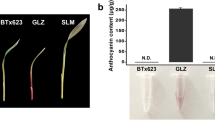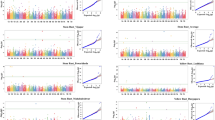Abstract
A three-locus model for rind phenotypes in watermelon (Citrullus lanatus) was previously proposed based on genetic analysis. These three loci, S (foreground stripe pattern), D (depth of rind color), and Dgo (background rind color), segregate in a Mendelian manner. Whole genome sequencing of watermelon offers a new strategy for marker development in these rind phenotype-related loci. A genotype analysis using subsets of 188, 273, 287 and 113 probes was performed for the ‘0901’, ‘10909’, ‘109905’ and ‘90509’ rind trait-segregating F2 populations, respectively. A total of 26, 34, 30 and 15 linkage groups with 175, 254, 269 and 79 probes were constructed for the ‘0901’, ‘10909’, ‘109905’ and ‘90509’ populations, respectively. The genetic order of the probes was mostly collinear with the physical order on the reference genome, except for some probes on chromosomes 1, 3 and 11. The three rind-related loci, S, D, and Dgo were anchored near chr6_25767 on chromosome 6, chr8_26061 on chromosome 8 and chr4_150/chr4_249 on chromosome 4, respectively. The three loci are located on different chromosomes, and the three-locus model was therefore verified through molecular genetic analysis. We suggest a rapid and practical marker development strategy that can be used not only for rind traits but also for other agriculturally important traits in watermelon and applied for conventional breeding.
Similar content being viewed by others

Literature Cited
Barham WS (1956) A study of the Royal golden watermelon with emphasis on the inheritance of the chlorotic condition characteristic of this variety. Proc Am Soc Hortic Sci 67:487–489
Elshire RJ, Glaubitz JC, Sun Q, Poland JA, Kawamoto K, Buckler ES, Mitchell SE (2011) A robust, simple genotyping -by-sequencing (GBS) approach for high diversity species. PLoS One 6:e19379
Guner N, Wehner TC (2003) Gene list for watermelon. Rep Cucurbit Genet Coop. 26:76–92
Guner N, Wehner TC (2004) The genes of watermelon. Hortic Sci 39:1175–1182
Guo S JZ, Sun H, Salse J, Lucas WJ, Zhang H, Zhang Y, Mao L, Ren Y, Wang Z (2013) The draft genome of watermelon (Citrullus lanatus) and resequencing of 20 diverse accessions. Nat Genet 45:51–58
Henderson WR (1991) Gene list for watermelon. Rep Cucurbit Genet Coop 14:129–138
Henderson WR (1992) Corrigenda to 1991 watermelon gene list (CGC14:129-138). Rep Cucurbit Genet Coop 15:110
Kim H, Han D, Kang J, Choi Y, Levi A, Lee GP, Park Y (2015) Sequence-characterized amplified polymorphism markers for selecting rind stripe pattern in watermelon (Citrullus lanatus L.). Hortic Environ Biotechnol 56:341–349
Kumar R, Wehner TC (2011) Discovery of second gene for solid dark green versus light green rind pattern in watermelon. J Hered 102:489–493
Li H, Durbin R (2009) Fast and accurate short read alignment with Burrows-Wheeler transform. Bioinformatics 25:1754–1760
Meyer RS, Purugganan MD (2013) Evolution of crop species: genetics of domestication and diversification. Nat Rev Genet 14:840–852
Park SW, Jung JK, Choi EA, Kwon JK, Kang JH, Jahn M, Kang BC (2014) An EST-based linkage map reveals chromosomal translocation in Capsicum. Mol Breed 34:963–975.
Poland JA, Rife TW (2012) Genotyping-by-sequencing for plant breeding and genetics. Plant Gen 5:92–102
Poole CF (1944) Genetics of cultivated cucurbits. J Hered 35:122–128
Porter DR (1933) Watermelon breeding. Hilgardia 7:585–624
Reddy UK, Nimmakayala P, Levi A, Abburi VL, Saminathan T, Tomason YR, Vajja G, Reddy R, Abburi L (2014) High-resolution genetic map for understanding the effect of genome-wide recombination rate on nucleotide diversity in watermelon. G3 (Bethesda) 4:2219–2230
Ren R, Ray R, Li P, Xu J, Zhang M, Liu G, Yao X, Kilian A, Yang X (2015) Construction of a high-density DArTseq SNP-based genetic map and identification of genomic regions with segregation distortion in a genetic population derived from a cross between feral and cultivated-type watermelon. Mol Genet Genomics 290:1457–1470
Ren Y, Zhao H, Kou Q, Jiang J, Guo S, Zhang H, Hou W, Zou X, Sun H (2012) A high resolution genetic map anchoring scaffolds of the sequenced watermelon genome. PLoS ONE 7:e29453
Rhee S, Han B, Jang YJ, Sim TY, Lee GP (2015) Construction of a genetic linkage map using a frame set of simple sequence repeat and high-resolution melting markers for watermelon (Citrullus spp.). Hortic Environ Biotechnol 56:669–676
Rhodes B, Dane F (1999) Gene list for watermelon. Rep Cucurbit Genet Coop 22:61–77
Rhodes B, Zhang X (1995) Gene list for watermelon. Rep Cucurbit Genet Coop 18:69–84
Schiex T, Gaspin C (1997) CARTHAGENE: constructing and joining maximum likelihood genetic maps. Proc Int Conf Intell Syst Mol Biol 5:258–267
Tian F, Stevens NM, Buckler ES (2009) Tracking footprints of maize domestication and evidence for a massive selective sweep on chromosome 10. Proc Natl Acad Sci USA 106 (Suppl 1):9979–9986
Weetman LM (1937) Inheritance and correlation of shape, size, and color in watermelon, Citrullus vulgaris Schrad. Iowa Agric Exp Stn Res Bull 228:224–256
Wehner TC (2008) Watermelons. In J Prohens, F Nuez, eds, Handbook of Plant Breeding. Vegetables Vol. I: Asteraceae, Brassicaceae, Chenopodiaceae, and Cucurbitaceae. Springer Verlag, New York. USA, pp 381–418
Wu F, Eannetta NT, Xu Y, Durrett R, Mazourek M, Jahn MM, Tanksley SD (2009) A COSII genetic map of the pepper genome provides a detailed picture of synteny with tomato and new insights into recent chromosome evolution in the genus capsicum. Theor Appl Genet 118:1279–1293
Yang H, Park S, Park Y, Lee GP, Kang S, Kim YK (2015) Linkage analysis of the three loci determining rind color and stripe pattern in watermelon. Korean J Hortic Sci Technol 33:559–565
Author information
Authors and Affiliations
Corresponding author
Electronic supplementary material
Rights and permissions
About this article
Cite this article
Park, Sw., Kim, KT., Kang, SC. et al. Rapid and practical molecular marker development for rind traits in watermelon. Hortic. Environ. Biotechnol. 57, 385–391 (2016). https://doi.org/10.1007/s13580-016-0005-0
Received:
Revised:
Accepted:
Published:
Issue Date:
DOI: https://doi.org/10.1007/s13580-016-0005-0



